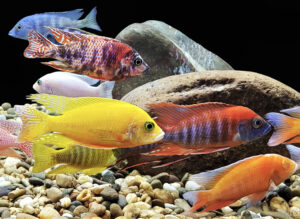
Learn how to care for peacock cichlids with this complete guide. Discover the best tank size, ideal setup, suitable tank mates, and how to extend their lifespan. Perfect for beginners and fish enthusiasts.
Introduction – Why Peacock Cichlids Are Amazing Pets
If you’ve ever seen a tank full of peacock cichlids, you know why they’re so popular. Their colors are breathtaking—bright blues, reds, and yellows that shimmer in the water like jewels. When I brought home my first group of peacock cichlids, I was hooked. They instantly became the centerpiece of my aquarium.
Answer first: Peacock cichlids are colorful, hardy, and relatively easy to care for if you give them the right tank, setup, and food.
In this guide, I’ll share everything I’ve learned from caring for these beauties—mistakes, successes, and tips that make the journey easier for you.
Understanding Peacock Cichlids
Peacock Cichlid Size
Peacock cichlids grow to about 4–6 inches in length. Males are usually larger and more colorful than females.
Quick answer: Adult peacock cichlids reach 4–6 inches in size.
Peacock Cichlid Lifespan
With proper care, peacock cichlids can live 6–8 years. Good water quality, a proper diet, and the right tank setup are key to helping them reach their full lifespan.
Quick answer: Peacock cichlids live 6–8 years with proper care.
Natural Behavior
These fish are considered semi-aggressive. They’re less aggressive than mbunas but can still show dominance—especially males. Watching their behavior is part of the fun.
Quick answer: Peacock cichlids are semi-aggressive but peaceful compared to many African cichlids.
Setting Up the Perfect Peacock Cichlid Tank
Peacock Cichlid Tank Size
A 55-gallon tank is the minimum recommended size for a small group. If you want a thriving, colorful display, go bigger—75 or even 90 gallons is even better.
Quick answer: Start with at least a 55-gallon tank for peacock cichlids.
Tank Setup Essentials
Peacocks love tanks that mimic their natural Lake Malawi habitat. Here’s what works best:
-
Filtration: Strong, reliable filter to keep water clean.
-
Heater: Keep water between 76–82°F.
-
Substrate: Sand is best, as they like to dig.
-
Decor: Rocks and caves give them hiding spots and reduce stress.
Quick answer: Use sand, rocks, a heater, and strong filtration for the ideal setup.
Water Parameters
Water stability is everything with cichlids. Keep conditions close to their natural environment:
-
pH: 7.5–8.5
-
Hardness: 8–20 dGH
-
Ammonia/Nitrite: Always 0
-
Nitrate: Below 40 ppm
Quick answer: Peacock cichlids thrive in pH 7.5–8.5, 76–82°F, with stable, clean water.
Choosing the Right Tank Mates
Compatible Tank Mates
Peacock cichlids mix well with:
-
Other peacock cichlids
-
Hap cichlids (similar temperament)
-
Synodontis catfish
-
Peaceful African cichlids
Quick answer: Best tank mates include other peaceful African cichlids of similar size.
Tank Mates to Avoid
Stay away from:
-
Mbunas (too aggressive)
-
Very small fish (may get eaten)
-
Overly aggressive species
Quick answer: Avoid mbunas and small fish that peacocks may bully or eat.
Feeding Peacock Cichlids
Diet Essentials
A healthy diet keeps their colors vibrant. Go for:
-
High-quality cichlid pellets
-
Occasional frozen foods like brine shrimp or bloodworms
-
Some vegetable matter for balance
Quick answer: Feed peacock cichlids pellets and occasional frozen foods for vibrant health.
What to Avoid
Skip fatty foods like beef heart or feeder fish—they cause digestive issues.
Quick answer: Avoid fatty foods and feeder fish to prevent health problems.
Feeding Frequency
Feed small portions 1–2 times per day. Only give what they can eat in 2–3 minutes.
Quick answer: Feed peacock cichlids once or twice daily in small portions.
Maintenance and Tank Care
Cleaning Schedule
Change 20–30% of the water weekly. This keeps toxins low and fish stress-free.
Quick answer: Do 20–30% weekly water changes to maintain a healthy tank.
Monitoring Water Quality
Use a test kit to check:
-
pH
-
Ammonia
-
Nitrite
-
Nitrate
Quick answer: Test your water weekly to keep peacock cichlids healthy.
Preventing Common Diseases
Common issues include:
-
Ich – white spots on body.
-
Bloat – from poor diet or stress.
-
Fin Rot – usually from bad water.
Quick answer: Clean water and proper diet prevent most peacock cichlid diseases.
Breeding Peacock Cichlids
Breeding Behavior
Peacocks are mouthbrooders. The male digs a pit, the female lays eggs, and then she carries them in her mouth until they hatch.
Quick answer: Peacock cichlids breed through mouthbrooding, where females carry eggs in their mouths.
How to Encourage Breeding
-
Provide a separate breeding tank.
-
Keep water conditions stable.
-
Feed high-quality food.
Quick answer: A stable tank and high-quality diet encourage breeding.
Fry Care
When the female releases fry, feed them baby brine shrimp or powdered fry food.
Quick answer: Feed baby brine shrimp to fry for fast growth.
Common Questions About Peacock Cichlid Care (FAQ Section)
How big do peacock cichlids get?
They reach 4–6 inches as adults.
What is the best tank size for peacock cichlids?
At least 55 gallons.
Can I keep peacock cichlids with other fish?
Yes, but only with peaceful African cichlids.
What is their lifespan?
6–8 years with proper care.
Are peacock cichlids beginner-friendly?
Yes, if you provide the right tank and diet.
My Personal Tips for Success with Peacock Cichlids
Here’s what I’ve learned from my own tanks:
-
Invest in a good filter. It saves you headaches later.
-
Feed a variety of foods. My cichlids look brighter when I mix in frozen brine shrimp.
-
Watch their behavior. If one fish is bullying others, rearrange rocks or add hiding spots.
These little changes make a huge difference.
Conclusion – Bringing Out the Best in Peacock Cichlids
Caring for peacock cichlids is rewarding. With the right tank size, mates, setup, and diet, these fish will thrive and bring unmatched color to your home.
If you’re thinking about keeping them, I encourage you to dive in. Watching their colors glow under the light is pure joy—it’s like having a living rainbow in your living room.
